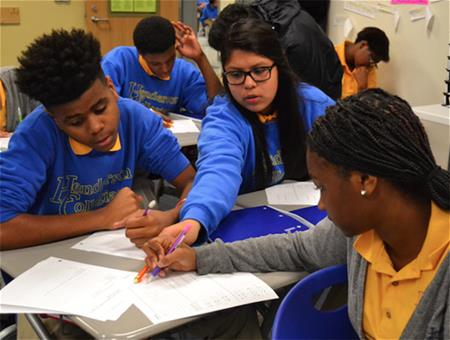
Brittany Bennett, Self-Help's Charter School Sector Leader
Self-Help makes loans to public charter schools, focusing on schools that provide high quality education for students in low-wealth communities who otherwise are relegated to poor school options, often by virtue of their zip codes, race or ability. Recently we have partnered with other Community Development Financial Institutions to find ways to make racial equity an integral part of our charter school lending process. Here Self-Help's Brittany Bennett (Charter School Sector Leader, Commercial Lending) describes how this effort has resulted in the development of an equity assessment tool that is already helping CDFIs incorporate equity into their loan decisions.
Expanding an understanding of ‘quality’ to include equity
In the summer of 2017, Self-Help’s charter school facilities lending team began working with educational equity nonprofit Village of Wisdom (VOW) to explore ways to assess a school’s performance through a racial equity lens. As a mission-focused lender, the team wanted to expand their understanding of a quality school by centering the experiences of students of color. They wanted to know how they might better understand the effects of a school’s curriculum, culture, or discipline practices on the sense of belonging and positive racial identity development for students of color.
Community Development Financial Institutions (CDFIs) had long evaluated academic performance based on standardized test results as a critical component of credit and mission alignment, but how might our due diligence look through a racial equity lens? What is our role as lenders in advocating for racial equity in the education sector generally, and with our school borrowers, specifically? How would employing an equity lens affect our lending criteria, loan volume, our risk, and relationships with borrowers?
With these questions in mind, fellow members of Self-Help’s team presented to peer CDFIs at the 2017 Opportunity Finance Network conference. They were joined by William Jackson from VOW and DeMar Pitman of Discriminology, a tech-based educational equity platform, who spoke about their work and learnings in the educational equity space and the need for powerful stakeholders like CDFIs, other lenders, and grant-makers to center equity in our financing decisions. A lively Q&A session at the end of the presentation sparked the idea to standardize the consideration of racial equity in CDFIs’ lending to schools. Out of this idea, the CDFI Racial Equity Collaborative on Education was born.

Self-Help has financed several loans for Henderson Collegiate, a K-12 charter school that has been serving students in rural Vance County, NC since 2010.
Developing an Equity Assessment Tool
The eight members of the Collaborative—Blue Hub, Capital Impact Partners, IFF, Nonprofit Finance Fund, LISC, Low Income Investment Fund, Reinvestment Fund, and Self-Help—began our work together in earnest in spring 2018. Together we hired VOW, Discriminology, and we are (Working to Extend Anti-Racist Education, a nonprofit advancing anti-racist education) to develop an equity assessment tool that could be used during loan underwriting. Over the next year, the consultant group conducted interviews with each CDFI, facilitated regular group calls, and brought us together for two in-person meetings to understand our lending processes and to share their expertise with the Collaborative. Each CDFI was at a different place in incorporating equity into its work, and each person was also at a different place in our personal understanding of systemic racism, which made the consultants’ guidance invaluable.
By early 2019, the consultant team had created the Racial Equity Matrix (REM) and the REM Screening Tool for CDFIs and other stakeholders to better evaluate a school’s institutional commitments to equitable practices, referred to as “equity focus areas” in the REM. (The full tool is owned and currently being adapted by VOW and Discriminology.) The tools are grounded in literature and research from experts in the field, and evaluate practices such as mindful discipline, culturally relevant curricula, and equitable assessments. As the final step in the consultants’ engagement, each Collaborative member piloted the REM Screening Tool with three existing school borrowers, gathered feedback from schools (many of whom were already engaged in racial equity practices and measures) and debriefed our experiences with the group. The REM and the process of developing it helped Collaborative members think about equity more clearly and gave us stronger questions to ask in our work with schools.
At the time of writing this post, each member CDFI is at a different place with adopting the REM tool, however, all eight remain committed to continued collective learning and to incorporating an equity lens into our work in some meaningful way. The effects of the current COVID-19 pandemic and national movement against racism and policy brutality reinforce the need for a collective commitment to equity, not just within CDFIs and schools, but in every institution and system that work together to maintain injustice and inequity for Black and brown people. This work can seem daunting when we consider all the ways racism shows up from criminal justice to education to healthcare, but when we listen to those most affected, work together, and focus on our spheres of influence, we can achieve change. Now is the time to act boldly to end racism. We hope the CDFI Racial Equity Collaborative on Education inspires you to join us in the pursuit of more just and equitable communities.
** ** **
Recently the Opportunity Finance Network posted an article co-authored by the partners in this racial equity initiative that describes the challenges and lessons learned during this project so far. Here's an excerpt:
"Moving toward anti-racism seems daunting when we are faced with the ubiquity of structural racism in education, housing, health care, law enforcement, and beyond; but when we listen to those most affected, work together, and focus on our spheres of influence, we can achieve change. We hope the Collaborative inspires others to join us in the pursuit of more just and equitable communities.
Challenges and Lessons Learned
- Shared language is critical. Establishing a common understanding of key equity concepts such as systemic, structural, and institutional racism, and white supremacist culture is critical to making our collaboration a success. Early on, we realized not all collaborative members had the same understanding or language to describe the racial inequities we were trying to evaluate. After a year of working together, we could no longer ignore those differences. Without shared language, we were limited not only in our ability to apply these concepts to an evaluation of a school’s equity practices, but also in our ability to live out our equity values as a group and to communicate effectively with one another about difficult topics. ..."
Read the entire piece at “Learning to Change: Reflections of the CDFI Racial Equity Collaborative on Education.”